#*Kallir
Explore tagged Tumblr posts
Text





Extended bounty hunting Season is so great
2 notes
·
View notes
Text

William Kallir
World fair
New York 1940
98 notes
·
View notes
Text
I would read a Kaladin x Rillir fic. I would make a Kaladin x Rillir fic. Hmgm.
#Kallir#haha#Rilladin#ahhaha#vauvely inspired off of anything by adrianne lenker#idk what spawned this other than that.#hgm.#stormlight archive#cosmere#the stormlight archive#brandon sanderson#sorchaposting#kaladin stormblessed#rillir roshone
3 notes
·
View notes
Text

Egon Schiele: Couple (1909) Watercolor and pencil, 44.5 x 31 cm
Museum of Art, Carnegie Institute also Carnegie Museum of Art, Pittsburgh
(Kallir d363)
228 notes
·
View notes
Text
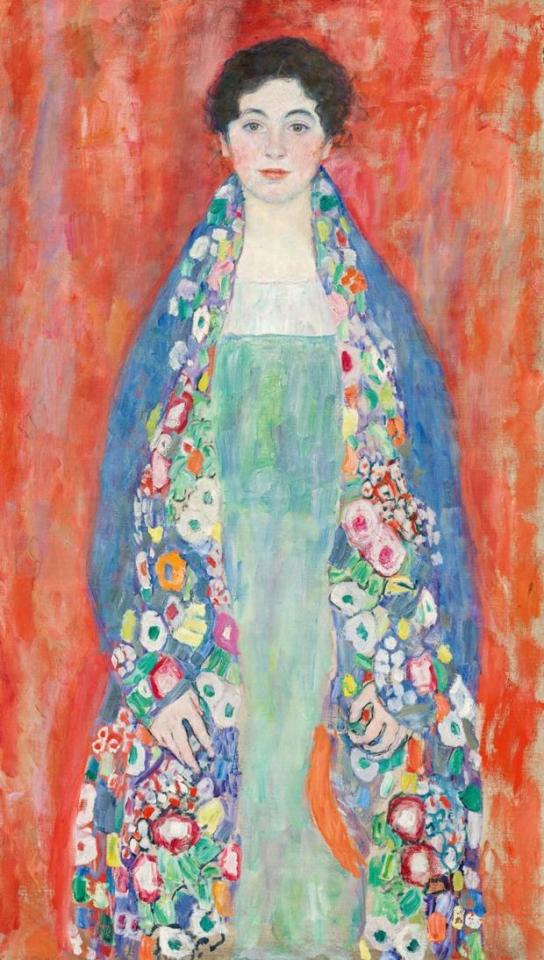
Gustav Klimt Portrait Found After Vanishing Nearly 100 Years Ago
It is one of the last works the artist painted before his death in 1918.
One of the last paintings by the renowned Austrian artist Gustav Klimt has miraculously been found after vanishing nearly 100 years ago.
The painting, titled Portrait of Fräulein Lieser, was found in Vienna after last being seen by the public in 1925. Until now, the only known photograph of the painting had been held in the archives of the Austrian National Library. The picture was likely taken in 1925 in connection with the Klimt exhibition by Otto Kallir-Nirenstein in the Neue Galerie, Vienna.
Since then, its location had been a mystery.
"The rediscovery of this portrait, one of the most beautiful of Klimt's last creative period, is a sensation," said the im Kinsky auction house in a statement announcing the discovery. "As a key figure of Viennese Art Nouveau, Gustav Klimt epitomizes fin de siècle Austrian Modernism more than any other artist. His work, particularly his portraits of successful women from the upper middle class at the turn of the century, enjoy the highest recognition worldwide."
The work of art will go up for auction at the im Kinsky auction house in Vienna on April 24 and is expected to fetch millions on the market.
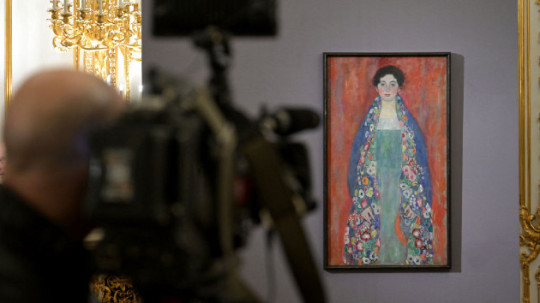
"Klimt's paintings rank in the top echelons of the international art market. His portraits of women are seldom offered at auctions. A painting of such rarity, artistic significance, and value has not been available on the art market in Central Europe for decades," im Kinsky auction house said. "This also applies to Austria, where no work of art of even approximate importance has been available."
The painting will now travel worldwide on short exhibitions until it is auctioned and is set to be presented at various locations internationally, including stops in Switzerland, Germany, Great Britain and Hong Kong.
The model for the painting is labeled as Fräulein Lieser, also known as Margarethe Constance Lieser (1899-1965), daughter of the Austrian industrial magnate Adolf Lieser. But new research by the im Kinsky auction house into the history and provenance of the masterpiece has opened up the possibility that Klimt's model could have been another member of the Lieser family -- either Helene Lieser (1898-1962), the first-born of Henriette Amalie Lieser-Landau and Justus Lieser, or their younger daughter, Annie Lieser (1901-1972), according to officials.
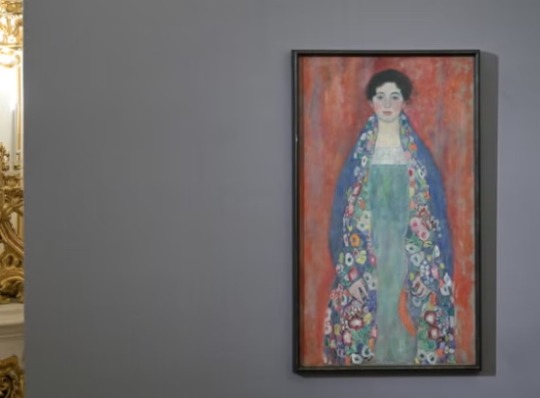
"In April and May 1917, the sitter visited Klimt's studio in Hietzing nine times to pose for him," im Kinsky said. "Klimt probably began the painting in May 1917. The painter chose a three-quarter portrait for his depiction and shows the young woman in a strictly frontal pose, close to the foreground, against a red, undefined background. A cape richly decorated with flowers is draped around her shoulders."
The portrait is thought to be one of Klimt's last paintings and was done shortly before he died of a stroke on Feb. 6, 1918. The painting was left, with several small portions of it unfinished, in his studio and it is thought that the painting was given to the family who had commissioned it after his death.
The painting, however, would soon vanish and the exact fate of the painting after 1925 is unclear.
"What is known is that it was acquired by a legal predecessor of the consignor in the 1960s and went to the current owner through three successive inheritances," im Kinsky auction house said.
ByJon Haworth.

#Gustav Klimt#Gustav Klimt Portrait Found After Vanishing Nearly 100 Years Ago#Gustav Klimt Portrait of Fräulein Lieser#austrian artist#painter#painting#art#artist#art work#art world#art news#history#history news
70 notes
·
View notes
Text
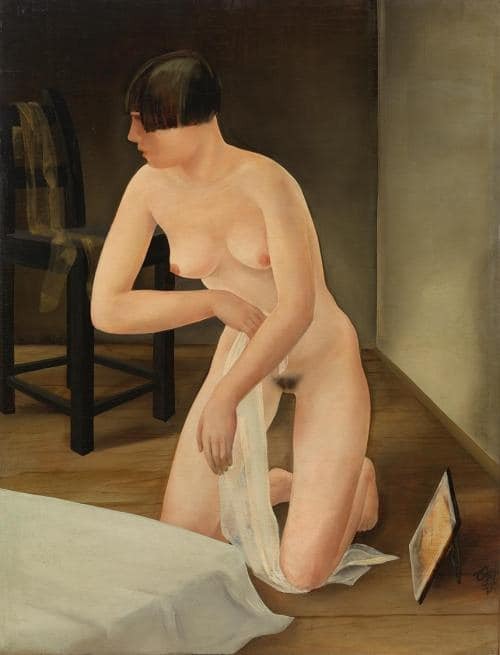
Otto Rudolf Schatz (1900 Wien – 1961 Wien), Kneeling, 1930, Oil on wood, 120 × 92 cm. Via Wien Museum.
Otto Rudolf Schatz was born on January 18, 1900, the son of a post office family in Vienna. From 1915 to 1918 Schatz studied at the Viennese Art Academy under Oskar Strnad and Anton von Kenner. In 1918 his studies were interrupted by military service in the First World War although he graduated in 1919. In 1923 Schatz became friends with the Viennese gallery owner Otto Kallir who became one of his most important patrons. Kallir continuously presented Schatz’s works in the Neue Galerie. In 1927 Schatz contributed woodcuts to the volume The New Town by the Berlin Büchergilde Gutenberg. From 1928 to 1938 he was a valued member in the Hagenbund in Vienna. When the National Socialists gained power in 1938 Schatz was forbidden to work. In 1938 he lived with his Jewish wife Valerie Wittal in Brno and in 1944 in Prague where he painted landscape miniatures. In 1944 Schatz was imprisoned in the Klettendorf labor camp and then transferred to the Graditz and Bistritz concentration camps.
45 notes
·
View notes
Text

EGON SCHIELE (Tulln an der Donau 1890 - 1918 Wien)
Bildnis Arthur Rössler, 1914
Kaltnadelradierung/Papier 31,9 x 45,1 cm
Edition von 1969 von Otto Kallir
verso monogrammiert und datiert OK 1969, sowie nummeriert 4/80, prachtvoller Druck
Provenienz Sammlung Chrastek, Wien
2 notes
·
View notes
Text

Grandma Moses, Cambridge Valley, 1942, oil on pressed wood, overall_1: 27 × 31 × 1 in. (68.6 × 78.7 × 2.5 cm), Smithsonian American Art Museum, Gift of the Kallir Family in Memory of Otto Kallir, 2021.71.1
2 notes
·
View notes
Text
More recently, Holger Zellentin informally suggested to me a Talmudic source for Q. 5:64, a passage in BT Menahot 29b. There, R. Judah relates in the name of Rav that when Moses went up to Mount Sinai to get the Torah from God (recorded in Exodus 19-20), he came upon God sitting and painstakingly drawing crowns on the letters of the Bible. Said Moses to God, 'Master of the Universe, who delays Your hand (mi me'akev yadcha)? In other words, Moses wished to know who was preventing God from finishing His transcription of the holy text and sending it down to the Israelites. God replied that in the future a scholar named 'Aqiba ben Joseph would arise and expound mountains of rabbinic teaching on each crown. Zellentin posited that according to the rabbis God here holds Himself back, restrains His own hand, in order 'to leave the interpretation of the Torah to the Rabbis'. Indeed, rabbinic teaching, here and elsewhere, celebrates the rabbinic enterprise of Torah explication as a sort of rabbinic-God partnership that is Divinely ordained. Zellentin, however, suggests that Q. 5:64 flips this rabbinic teaching on its head, using the Talmud's own language to reject its claims. Unlike the rabbis, the Qur'an maintains that God does not restrain Himself in order to allow human participation in His revelation; what's more, for the Qur'an the claim that He does so borders on sacrilege. […] Zellentin's proposal takes into account the often polemical nature of the Qur'an's use of the texts of earlier monotheist traditions against them[.]
Shari L. Lowin (The Jews Say the Hand of God is Chained: Q. 5:64 as a Response to a Midrash in a piyyut by R. El'azar ha-Kallir). Italics original. If the title of her article doesn't make it clear, Lowin does not think this interpretation is correct; I still found it interesting.
2 notes
·
View notes
Text
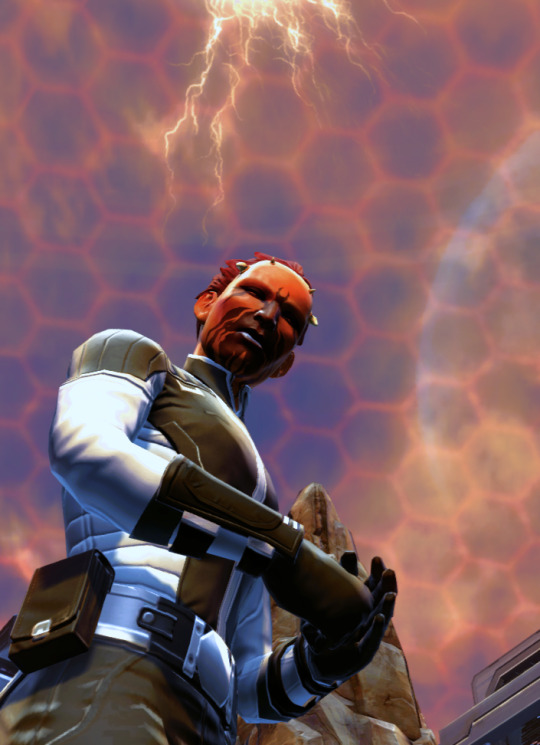
That 5'2" agent starts to look different from the perspective of being knocked flat. . .
12 notes
·
View notes
Text

William Kallir
9th Avenue
Chicago 1939
86 notes
·
View notes
Note
OMG YOU WANNA KNOW MORE ABOUT BLAISE AND CALLIN????
Okay so brief explanation of the world they live in: Kallir is a small continent separated from the rest of the world by Ocean and mountains, and has three countries in it: Sinoral, Mordan, and Forwestia. (Forwestia isn’t relevant in this explanation bc it's a secret and few people from the other two know it exists)
Like 25 years ago, Mordan’s king and queen were overthrown by their advisor Corgan. They fled and eventually were killed by said advisor. Corgan is not a very good king, he’s too strict in taxes and pretty much lets crime run rampant.
So there's a rebellion called the Jotanna (the j is pronounced like 'y') based in a small village near the border.
Callin's real last name is Butcher bc of his parents' job but his friends call him Lightweight because... well yk lol. He grew up in Northwich, a tiny town nestled in the southern foothills. He has one little sister. He joined the rebellion as soon as he was of age (17 in this world).
Blaise Larimer is the sixth son out of twelve kids in a reasonably high up noble family. Because he's in the middle, what he does doesn't really reflect on his family so he also joined the rebellion at 17. He and Callin immediately became best friends.
Callin and Blaise both enjoy a bit of a party, so they bonded partially when going out to bars. Callin is an absolute light weight, like one drink and he's slurring, thus the last name. The two of them are really close, tell each other everything, share food and silverware, and they have definitely kissed while drunk a couple times.
Blaise is gay and doesn't really date much. Callin is bi and a bit of a flirt (ik ik stereotyping but tbf i was 13 when I made this guy up). For like a year, Callin has girlfriend who doesn't really like how close he is with Blaise, who hates her. Anyway, she ends up cheating on Callin so they break up.
Eventually, Callin and Blaise end up in a queer platonic relationship with each other, best friends who kiss sometimes kind of vibe yk?
Anyway this is also really funny that I have so much backstory for these guys because they are solidly side characters lmao (I love them sm tho)
Lmk if you have more questions!
STOPPP WHAT THAT IS SO COOL AND THE WORLDBUILDING????? OMGGG. WOAHGG. such interesting character relationships!
no literally i have that where side characters become randomly developed lol 😂😅
1 note
·
View note
Text

Egon Schiele: Standing Figure with Halo (1913)
Gouache, watercolor, and pencil
48,3 x 31,7 cm
Private collection
(Kallir d1421)
16 notes
·
View notes
Photo
Egon Schiele
Egon Leo Adolf Ludwig Schiele (12 de junho de 1890 – 31 de outubro de 1918) foi um pintor expressionistaaustríaco. Seu trabalho é conhecido por sua intensidade e sexualidade crua, e pelos muitos autorretratos que o artista produziu, incluindo autorretratos nus. As formas corporais retorcidas e a linha expressiva que caracterizam as pinturas e desenhos de Schiele marcam o artista como um dos primeiros expoentes do expressionismo. Gustav Klimt, um pintor figurativo do início do século XX, foi um mentor de Schiele.
Estilo
Jane Kallir descreveu o trabalho de Schiele como grotesco, erótico, pornográfico ou perturbador, com foco em sexo, morte e descoberta. Ele se concentrou em retratos de outros e também de si mesmo. Em seus últimos anos, embora ainda trabalhasse frequentemente com nus, eles eram feitos de uma forma mais realista. Desde jovem, Schiele desenhava com 'fluência maníaca'.
O crítico de arte Martin Gayford escreveu no The Spectator : 'Ele [Schiele] encontrou seu estilo distinto muito cedo. Toda a sua obra é a de um jovem; a maior parte do trabalho na primeira das duas salas desta pequena exposição densamente lotada data de 1910 a 1911, quando Schiele (1890–1918) tinha apenas 20 anos. Isso ajuda a explicar algumas tendências: uma preocupação meio enojada com a sexualidade e um fascínio igualmente enjoado em examinar seu eu nu. As figuras masculinas parecem ter sido modeladas principalmente pelo artista, embora seja difícil ter certeza, pois a cabeça geralmente não é incluída.'
Kallir e o acadêmico Gerald Izenberg consideram Schiele fluido em sexualidade e gênero. Kallir diz que Schiele estava "lutando com seus próprios sentimentos sexuais e normas de gênero" durante um período histórico de mudanças nas expectativas de gênero, o movimento feminista inicial e a criminalização da homossexualidade . Alguns críticos do século XXI leram sua arte como queer .
Um fato menos conhecido sobre a carreira de Schiele é que, durante seus estudos na Escola de Artes e Ofícios de Viena, ele explorou a escultura e criou uma série de esculturas de argila e gesso em pequena escala.

Egon Schiele: (1890-1918) Embrace (1914)
156 notes
·
View notes
Link
Check out this listing I just added to my Poshmark closet: GRANDMA MOSES AMERICAN PRIMITIVE 40 PAINTINGS AND HER AUTOBIOGRAPHY OTTO KALLIR.
0 notes
